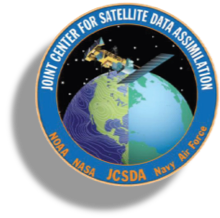On Thursday, October 26, the JCSDA core team and partners at NOAA, NASA, U.S. Navy and Air Force, and the UK Met Office met virtually and in-person to go over accomplishments from the last three months and discuss future goals. Exciting milestones include two partners passing thresholds for JEDI operations and spack-stack 1.5.0 being officially put into use by UFS!
The observations team started off, with accomplishments this quarter including:
All-sky assimilation for GOES water vapor channels
atmospheric non-cycled hybrid 3DEnVar with FV3 deterministic at C384 and EDA with 25 members at C192
Transitioned to CRTM 3.0
Updated converters and ctest for snow depth
Partners: GNSSRO ioda converter implemented into NRL workflow; PR in review from NASA separating passive and active sensors in UFO; NRL UFO validations ongoing
CRTM came next, with just as many exciting developments:
Substantial improvement in snow-covered surfaces
Release of CRTM 3.0, which has full polarization solver capability and multiple aerosol species
Progress on computing top of atmosphere reflectance for near-vis sensors
Partners: Issac Moradi at GMAO is working on space-based radar for CRTM; STAR has stepped up to work on generating sensor coefficients after Patrick Stegmann left
After CRTM came SOCA, showing excellent new capabilities:
Key QC filters for in-situ observations are completed and ready for real-time assimilation
3DFGAT and 4DEnVAR capabilities added to workflow
Added a small-scale correlation operator for use with smaller-scale grids
Partners: Calibration of the implementation of the JEDI/SOCA hybrid EnVar at NOAA EMC; testing of in situ observations QC filters with the marine observations in the NCEP data tank
Next up was atmospheric COMPOsition, with new resolution scales and prep for even more exciting work:
7 km resolution in CONUS with the FV3 stretch grid
ran geos-cf forecast in ewok 3DVar experiments
Prepping the JEDI system to assimilate TEMPO data, and ready for tests with preliminary data
Partners: NASA GMAO implemented TROPOMI monitoring suite; NOAA EMC further tuned global aerosol covariances in prep for upcoming GFS, and have tested for three seasons
Algo followed up with equally impressive results:
4DEnVar with or without partial decomp
Ran experiments with 4DEnVar with MOM6, MPAS-JEDI, FV3-JEDI
Generic capability to output analysis and increments interpolated to lat-long grid extended to interpolate for pressure levels
Merged JEDI framework for obs operators probing horizontally extended regions
Partners: Working with GMAO on our design working with GSI; collaboration with the UK Met Office added control pert EDA capability in OOPS and workflow; 480 km and 120 km 3DVar MPAS Skylab experiments done
Infrastructure finished the morning with several exciting accomplishments:
2 spack-stack releases in Quarter 2, bug fix release 1.4.1 and spack stack 1.5.0
Increased speed of store and fetch in R2D2 by orders of magnitude
Added new lifetime R2D2 index which will allow future addition of automatic data scrubber
Optimized and extended dedicated cluster for CI testing
Partners: spack-stack 1.5.0 officially in use by UFS; ran Skylab V6 release experiments on NOAA parallel works; worked with UKMO on CI testing on Azure
Congratulations to the entire JCSDA staff and all of our partners and in-kinds for these big steps forward! Keep an eye out for upcoming developments with TEMPO, coupled h(x), and much more.
If you have any questions or would like further information, you can visit us at https://jcsda.org/ or reach the team at jcsda-info@ucar.edu.
Photo by Tapio Haaja on Unsplash

